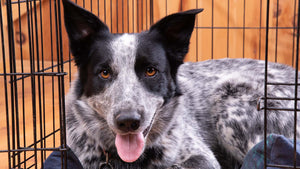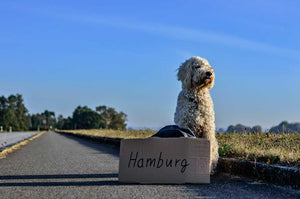Your Cart is Empty
💗FREE shipping on Oprah's Favorite Dog Walking Bag! Everything ships FREE on orders over $30 💗
💗FREE shipping on Oprah's Favorite Dog Walking Bag! Everything ships FREE on orders over $30 💗
💗FREE shipping on Oprah's Favorite Dog Walking Bag! Everything ships FREE on orders over $30 💗
💗FREE shipping on Oprah's Favorite Dog Walking Bag! Everything ships FREE on orders over $30 💗
Add description, images, menus and links to your mega menu
A column with no settings can be used as a spacer
Link to your collections, sales and even external links
Add up to five columns
Add description, images, menus and links to your mega menu
A column with no settings can be used as a spacer
Link to your collections, sales and even external links
Add up to five columns
November 02, 2022 5 min read
Dogs use their noses all the time. Their noses are important not only to smell but also to navigate the world around them. For this reason, it’s important for dogs’ noses to remain wet so that they can better interpret scents and avoid discomfort. Though a dog’s nose should be moderately wet, an excessively wet or dripping nose can be a sign of underlying problems.
Dogs differ from humans in how they use their noses, and their noses are much more powerful than ours. Our noses have, on average, about 6 million olfactory sensors. That may sound like a lot, but dogs have us majorly beat with up to 300 million olfactory sensors!
Dogs also have more neuroreceptors designed to process scents in their brains, which is why they have a sharper sense of smell than we do. While we use our noses primarily for breathing, dogs really rely on their olfactory senses to perceive their surroundings. You’ve probably noticed that dogs dive into everything nose-first. This holds true whether they’re uncovering concealed narcotics at an airport or deciding if the turmeric doggy treats you just made are worth a nibble.
The short answer to this question is yes. It’s important for a dog’s nose to be wet because it helps them better use their olfactory senses. The canine nose contains glands that secrete mucus, which serves two functions.
First, a dog’s nasal mucus helps keep the nose moist and healthy. This prevents your dog from developing a dried, cracked nose or in severe cases, hyperkeratosis, which can ruin their sense of smell and even affect their quality of life. Wet noses are the best noses!
The second important function of nasal mucus is helping dogs detect scents better. A thin mucus layer coats the nose to absorb scent particles, which travel through the olfactory receptors to the brain where they are decoded.
In addition to their acute sense of smell, dogs use their noses to cool off. Dogs only have three ways of cooling off their bodies: releasing heat through their noses, paw pads, and panting. Your dog's nose becomes wetter in the summer because it acts as a cooling mechanism to help them regulate their body temperature.
A dog’s nose should be wet enough to help with breathing, scent detection, and temperature regulation. A moist nose is important, but an excessively wet snout is worth investigating, as it could be a sign of an underlying health condition.
So how wet is cause for concern? Generally, your dog should have a thin film of mucus covering their nose. Their nose should feel slightly wet and cold to the touch, but your fingers should not feel drenched and slippery with mucus after touching their nose.
Sometimes, it’s normal for tiny droplets to form on dog's nose, especially when a dog is cooling off. But if your dog’s nose is constantly dripping, it may be time to book a visit to the vet.
A runny nose may or may not be harmless depending on what other symptoms you notice. Nose discharge in dogs can indicate allergies, respiratory infections or other signs of illness, nasal obstruction, or disease. Physical defects can also cause runny noses in dogs.
Allergies
A runny nose with clear discharge could mean that your dog has allergies. As spring comes around the corner each year, many dogs are likely to get pollen allergies. Other causes of allergies in dogs include:
In many cases, an allergy-induced runny nose is accompanied by sneezing, itchiness, coughing, or eye discharge. Severe forms of allergies may even cause nose bleeds and breathing difficulties. If you suspect that your dog may be suffering from allergies, it’s important to talk to your vet.
Infections
Nasal discharge that is green, yellow, or cloudy can be a sign of viral, bacterial, or fungal infection. This may be accompanied by coughing, nose bleeds, or a foul odor. Proper diagnosis by a vet will help identify the cause of symptoms and determine whether your dog needs prescription meds to clear up their infection.
Nasal blockage
A runny nose could simply mean that your dog has something stuck in their nostrils. This could be a blade of grass, a tiny seed from a plant, or an obscure object. You may notice your dog pawing their nose constantly or snorting to try and get the object out.
Examine your dog's nostrils for any visible blockages. If you can see an object blocking their nose, you may try to gently remove it with tweezers.
It’s important that you are extremely careful when trying to remove anything from your dog’s nose. If an object is stuck farther up, always contact your vet instead of trying to remove it yourself. In some cases, your pet may need to be sedated to remove any stubborn objects in their nose. Antibiotics can help clear bacterial infections caused by a blockage.
Disease
Viral diseases like distemper can cause a fever and runny nose in your dog. Rocky Mountain Spotted Fever, a more common disease in the spring, is caused by infected ticks. It can cause fever, lethargy, coughing, and a runny, wet nose in your dog. If you notice any of these symptoms or if your dog is acting otherwise sick, it’s always a good idea to take them to the vet.
Physical issues
Dogs born with physical abnormalities like a cleft palate are more likely to experience nasal discharge. Also, dogs with a nasal fistula - a hole running from the nose to the mouth - can experience a nose that is runnier than most. Nasal tumors and polyps in dogs can also cause a runny nose, which may have blood and pus in the discharge.
Your dog's snout probably occasionally changes from wet and cool to warm and dry, which is normal. Some dog breeds suffer from dry noses more than others, particularly flat-face breeds like French bulldogs and pugs. It’s also possible that a partially dry dog nose could be the result of a sunny day or spending too much time around a heater.
So when should a dry dog nose worry you?
If your dog's snout is completely dry, despite their efforts to moisten it with licks, then there may be a problem. Some of the reasons for drier noses include:
A vet can help determine if a dry dog nose is disease related and suggest the right course of treatment. It’s important to ensure that your dog is well hydrated throughout the day, which can help avoid a dry dog nose due to dehydration or heat.
How to Soothe a Dry Dog Nose
Moisturizing salves like Puppington’s very own Pup Wax can help soothe your dog’s dry or cracked nose. Dry dog noses can be uncomfortable and even problematic for your dog. Pup Wax acts as emergency repair for dry, cracked noses and paws as well as ongoing maintenance to keep your dog's nose in balance. It's made in the USA from organic ingredients and is totally free of toxins – with a magical recipe specially formulated to protect and prevent dry noses and paws.
Conclusion
A wet dog nose usually indicates good health and that their olfactory senses are working well. A runny nose with discolored discharge or extra drainage could indicate infection, disease, or blockage and should be taken care of by a vet immediately. A very dry nose can also indicate underlying issues like hyperkeratosis, disease, dehydration, or sunburn. Quality dog nose balms like Pup Wax, adequate hydration, and regular checkups from your vet can help you ensure better boops and a happy, healthy dog!


Comments will be approved before showing up.